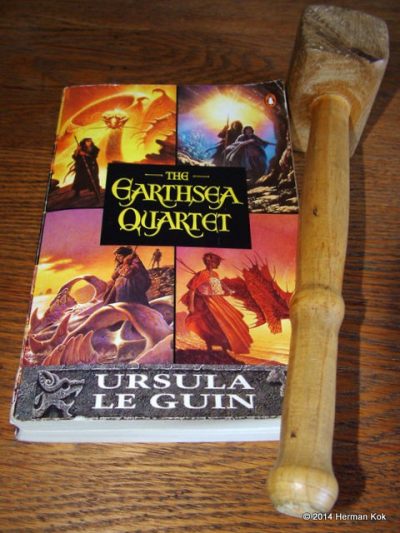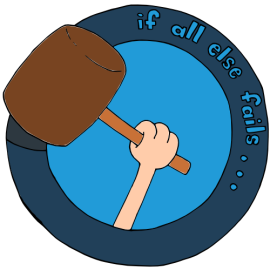
Publisher: Penguin Books
One cannot mention the great names in fantasy fiction without including in the list Ursula K. Le Guin, and in particular her Earthsea novels. I had long been on the lookout for her novels when earlier this year I discovered this omnibus of the first four Earthsea books in a second-hand shop. I read A Wizard of Earthsea and The Tombs of Atuan back-to-back and decided I’d do a joint review of the two.
A Wizard of Earthsea tells the story of a young boy who discovers that he has the gift of magic. After he saves his village from invaders from across the sea he becomes apprentice to the mage Ogion who gives him his true name, Ged. After some time with Ogion Ged travels to the wizard school on the island of Roke to further his own training. On a dare he accidentally releases an evil shadow into the world, a shadow which pursues him across the length and breadth of Earthsea and which he needs to figure out how to defeat if he is ever to have peace.
The Tombs of Atuan follows Tenar, a girl who at a young age becomes Arha, The Eaten One, High Priestess of the Tombs of Atuan and servant of the Nameless Ones, the most powerful gods of the Kargad lands. We are told how she learns to do her duty and gets to know her domain under the earth. Then one day she discovers a man in the tombs, a place where no man may ever set foot. And she realises this man is a wizard who has come from across the sea to steal the most precious relic from the treasury of the Dark Ones.
 A Wizard of Earthsea was a delightful read. In terms of language it reminded me of the style used in The Lord of the Rings, but without the long-winded description and endless lists of names of people who died in battles (which probably partly explains why this story is so much shorter than Tolkien’s master work). Le Guin managed to create a beautiful and diverse world, where dragons can talk and where magic is infused in every aspect of life. I especially liked her school of wizardry (yeah, JK didn’t think of that first), and the system of magic where you gain power over something by knowing it’s true name.
A Wizard of Earthsea was a delightful read. In terms of language it reminded me of the style used in The Lord of the Rings, but without the long-winded description and endless lists of names of people who died in battles (which probably partly explains why this story is so much shorter than Tolkien’s master work). Le Guin managed to create a beautiful and diverse world, where dragons can talk and where magic is infused in every aspect of life. I especially liked her school of wizardry (yeah, JK didn’t think of that first), and the system of magic where you gain power over something by knowing it’s true name.
Ged is a loveable character. It quickly becomes apparent that he is incredibly powerful, but it is also obvious from an early stage that he has his weaknesses and that his greatest battle will ultimately be against himself. While this element is present in most good fiction, the focus on it made this novel a pleasant break from the normal epic-battle-between-good-and-evil which usually characterises high and epic fantasy.
 The Tombs of Atuan, on the other hand, was a disappointment, in large part I think due to the unavoidable comparison to the first. While A Wizard of Earthsea had a constant movement and a high level of tension throughout, The Tombs of Atuan was rather dull. The entire story takes place in one location. The descriptions are vivid and there is the constant mystery of the tombs, but not much happens aside from the rivalries between Arha and some of the older priestesses.
The Tombs of Atuan, on the other hand, was a disappointment, in large part I think due to the unavoidable comparison to the first. While A Wizard of Earthsea had a constant movement and a high level of tension throughout, The Tombs of Atuan was rather dull. The entire story takes place in one location. The descriptions are vivid and there is the constant mystery of the tombs, but not much happens aside from the rivalries between Arha and some of the older priestesses.
It seems that the intention was to create a sense of the loneliness Arha experiences, a loneliness which is dispelled when she discovers the intruder in her domain, but for most of the novel I was just wishing the story would start already. I got the feeling that this story was simply setting up Tenar and Ged for the events that are to come in the third instalment, and if I didn’t know there was third I probably wouldn’t have finished it. (Reading some other reviews of this novel I think I might have missed something, so I’ll probably revisit it at some time.)
That said, it is clear that Le Guin knows her craft and I’ll be on the lookout for more of her novels once I’ve read the remaining two titles in The Earthsea Quartet.
Related articles
(Warning: Some of these contain spoilers)
- I Was Wrong: I like Ged Better than Arha (apilgriminnarnia.com)
- “A Wizard of Earthsea” by Ursula Le Guin (zezee112.wordpress.com)
- A Wizard of Earthsea (neighbro2books.wordpress.com)
- “The Tombs of Atuan” by Ursula Le Guin (zezee112.wordpress.com)
- Freedom’s Burden: The Tombs of Atuan (ekostories.com)

I try to send you something useful and this is the thanks I get.
The Latvian Folk Tale submission here:
https://kokkieh.wordpress.com/2014/08/04/featuring-karlboesman/
was inspired by this wildly popular blogger (and regular commenter of mine) here:
http://expateyeonlatvia.wordpress.com/2014/08/03/youll-miss-me-when-im-gone/
She’ll be on her way to visit but she won’t be able to comment because you turned comments off.
LikeLike
I turned off comments in the hope it will make people leave their comments on the linked posts. I’ll go study up on Latvian folk tales (as if I don’t already have enough studying to do). Luckily that challenge is still some weeks off. I’ll give that blog a look as well 😀
P.S. Sorry that this one landed in moderation – comments with two or more links get held back automatically.
LikeLike
Not a problem. I know that rule about links.
LikeLike
Le Guin was a hugely talented writer – for me, ‘A Wizard of Earthsea’ remains one of my favourite fantasy novels. I believe she did her own maps, too.
LikeLike
And those maps are so detailed. She makes the whole exercise seem effortless. I can only imagine the level of effort she had to put in to achieve that 😀
LikeLike
I found it out the hard way. I decided to draw up a couple of maps as part of the world-building for the novel I keep putting off writing. Um…suffice to say, there are amoeba on Saturn that can draw better than I can. The effort generated a whole level of respect for people who (a) draw their own fantasy world maps, and (b) do it to publishable standard – like LeGuin.
LikeLike
I’ve also tried it. My first attempt at a first novel was an epic fantasy. I have an old Reader’s Digest atlas with some beautiful maps of the ocean floor. I copied and adapted the floor of the Pacific as my kingdom. Turned out pretty well, though the story didn’t make it past 5000 words. Maybe one day when I know what I’m doing…
LikeLike
I really liked the stories in this book. I thought they were so beautifully written. I will admit that sometimes I’m so bewitched by the way a story is written that I don’t pay as much attention to the story as I should, so sometimes I miss nuances.
LikeLike
That’s it, yes. Le Guin writes beautifully. That’s another reason why I could “forgive” the almost absent plot in Tombs – the writing itself made up for it.
LikeLike